Enhanced IL-10 production in response to hepatitis C virus proteins by peripheral blood mononuclear cells from human immunodeficiency virus-monoinfected individuals
- PMID: 18554409
- PMCID: PMC2443791
- DOI: 10.1186/1471-2172-9-28
Enhanced IL-10 production in response to hepatitis C virus proteins by peripheral blood mononuclear cells from human immunodeficiency virus-monoinfected individuals
Abstract
Background: Multiple immune evasion strategies by which HCV establishes chronic infection have been proposed, including manipulation of cytokine responses. Prior infection with HIV increases the likelihood of chronic HCV infection and accelerates development of HCV-related morbidity. Therefore, we investigated in vitro cytokine responses to HCV structural and non-structural proteins in peripheral blood mononuclear cells (PBMC) from uninfected, HIV-infected, HCV-infected and HIV/HCV-coinfected individuals.
Results: Intracellular flow cytometry was used to assess IL-2, IL-10, IL-12, and IFN-gamma production by freshly isolated PBMC incubated for 16 hours with recombinant HCV core, non-structural protein 3 (NS3), and NS4 proteins. Anti-HCV cellular responses were assessed in HIV/HCV-coinfected individuals by 3H-thymidine proliferation assay. Exposure to HCV antigens increased IL-10 production by PBMC, especially in uninfected and HIV-monoinfected individuals. This IL-10 response was attenuated in chronic HCV infection even with HCV/HIV-coinfection. The cells producing IL-10 in response to HCV proteins in vitro matched a PBMC subset recently shown to constitutively produce IL-10 in vivo. This subset was found at similar frequencies in uninfected, HIV-infected, HCV-infected and HIV/HCV-coinfected individuals before exposure to HCV proteins. HCV-specific T cell proliferation was detectable in only one HIV/HCV-coinfected individual who demonstrated no HCV-induced IL-10 response.
Conclusion: This pattern suggests that selective induction of IL-10 in uninfected individuals and especially in HIV-monoinfected individuals plays a role in establishing chronic HCV infection and conversely, that attenuation of this response, once chronic infection is established, favours development of hepatic immunopathology.
Figures
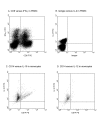
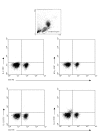
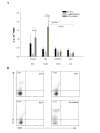
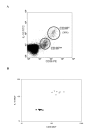
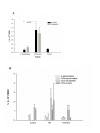
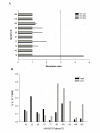
Similar articles
-
HCV Specific IL-21 Producing T Cells but Not IL-17A Producing T Cells Are Associated with HCV Viral Control in HIV/HCV Coinfection.PLoS One. 2016 Apr 28;11(4):e0154433. doi: 10.1371/journal.pone.0154433. eCollection 2016. PLoS One. 2016. PMID: 27124305 Free PMC article.
-
Hepatic compartmentalization of exhausted and regulatory cells in HIV/HCV-coinfected patients.J Viral Hepat. 2015 Mar;22(3):281-8. doi: 10.1111/jvh.12291. Epub 2014 Sep 1. J Viral Hepat. 2015. PMID: 25174689
-
Hepatitis C virus genotype and HIV coinfection affect cytokine mRNA levels in unstimulated PBMC but do not shift the T1/T2 balance.Immunol Cell Biol. 2006 Aug;84(4):390-5. doi: 10.1111/j.1440-1711.2006.01451.x. Immunol Cell Biol. 2006. PMID: 16834574
-
Coinfection with HIV-1 and HCV--a one-two punch.Gastroenterology. 2009 Sep;137(3):795-814. doi: 10.1053/j.gastro.2009.06.040. Epub 2009 Jun 21. Gastroenterology. 2009. PMID: 19549523 Free PMC article. Review.
-
Immunity and hepatitis C: a review.Curr HIV/AIDS Rep. 2013 Mar;10(1):51-8. doi: 10.1007/s11904-012-0146-4. Curr HIV/AIDS Rep. 2013. PMID: 23180007 Free PMC article. Review.
Cited by
-
Decrease of T-cells exhaustion markers programmed cell death-1 and T-cell immunoglobulin and mucin domain-containing protein 3 and plasma IL-10 levels after successful treatment of chronic hepatitis C.Sci Rep. 2020 Sep 29;10(1):16060. doi: 10.1038/s41598-020-73137-6. Sci Rep. 2020. PMID: 32994477 Free PMC article.
-
Unique Cytokine/Chemokine Signatures for HIV-1 and HCV Mono-infection versus Co-infection as Determined by the Luminex® Analyses.J Clin Cell Immunol. 2011 Jan 7;2(1):1000104. doi: 10.4172/2155-9899.1000104. J Clin Cell Immunol. 2011. PMID: 21866203 Free PMC article.
-
Characterization of HCV-specific CD4+Th17 immunity in recurrent hepatitis C-induced liver allograft fibrosis.Am J Transplant. 2011 Apr;11(4):775-85. doi: 10.1111/j.1600-6143.2011.03458.x. Am J Transplant. 2011. PMID: 21446979 Free PMC article.
-
The anti-idiotypic antibody 1F7 stimulates monocyte interleukin-10 production and induces endotoxin tolerance.J Inflamm (Lond). 2013 Apr 5;10(1):14. doi: 10.1186/1476-9255-10-14. J Inflamm (Lond). 2013. PMID: 23561395 Free PMC article.
-
Distribution and characterization of IL-10-secreting cells in lymphoid tissues of PCV2-infected pigs.J Vet Sci. 2010 Sep;11(3):177-83. doi: 10.4142/jvs.2010.11.3.177. J Vet Sci. 2010. PMID: 20706023 Free PMC article.
References
-
- Krauss O, Hollinshead R, Hollinshead M, Smith GL. An investigation of incorporation of cellular antigens into vaccinia virus particles. J Gen Virol. 2002;83:2347–2359. - PubMed
Publication types
MeSH terms
Substances
LinkOut - more resources
Full Text Sources
Medical

